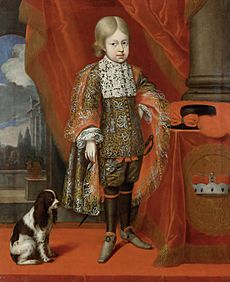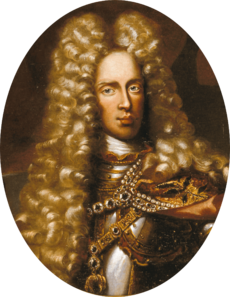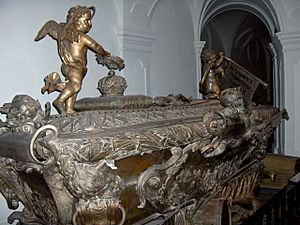Joseph I, Holy Roman Emperor facts for kids
Quick facts for kids Joseph I |
|||||
|---|---|---|---|---|---|
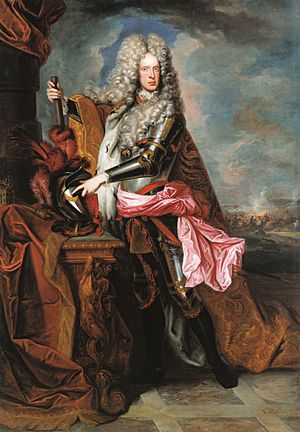
Portrait by Frans van Stampart, c. 1705
|
|||||
| Holy Roman Emperor (more...) | |||||
| Reign | 5 May 1705 – 17 April 1711 | ||||
| Predecessor | Leopold I | ||||
| Successor | Charles VI | ||||
| Born | 26 July 1678 Vienna, Austria |
||||
| Died | 17 April 1711 (aged 32) Vienna, Austria |
||||
| Burial | Imperial Crypt, Vienna | ||||
| Spouse |
Wilhelmine Amalie of Brunswick
(m. 1696) |
||||
| Issue | Maria Josepha, Queen of Poland Archduke Leopold Joseph Maria Amalia, Holy Roman Empress |
||||
|
|||||
| House | House of Habsburg | ||||
| Father | Leopold I, Holy Roman Emperor | ||||
| Mother | Eleonore Magdalene of Neuburg | ||||
| Religion | Roman Catholicism | ||||
| Signature |  |
||||
Joseph I (born Joseph Jacob Ignaz Johann Anton Eustachius; 26 July 1678 – 17 April 1711) was a powerful ruler. He was the Holy Roman Emperor and led the Austrian Habsburg monarchy from 1705 until his death in 1711. He was the oldest son of Emperor Leopold I and his third wife, Eleonor Magdalene of Neuburg.
Joseph became King of Hungary when he was nine years old in 1687. He was elected King of the Romans at age eleven in 1690. When his father died, Joseph took over the thrones of Bohemia and the Holy Roman Empire.
He continued the War of the Spanish Succession, which his father had started against Louis XIV of France. Joseph wanted his younger brother Charles (who later became Emperor Charles VI) to become King of Spain. Thanks to the victories of his general, Prince Eugene of Savoy, Austria became very powerful in Italy. Joseph also faced a long rebellion in Hungary, encouraged by Louis XIV. These conflicts were not finished until the Treaty of Utrecht, after Joseph's death.
His motto was Amore et Timore, which means "Through Love and Fear" in Latin.
Contents
Early Life of Joseph I
Joseph was born in Vienna, the capital of Austria. He had a strict education from Charles Theodore, Prince of Salm. This made him a very good linguist, meaning he could speak many languages. He was less religious than his parents and family. Instead, he was interested in the ideas of the early Age of Enlightenment, which focused on reason and new ways of thinking. Joseph loved two things very much: music and hunting.
Joseph was the first son born to his parents. However, he was his father's third son and seventh child overall. His father, Leopold, had been married twice before. Joseph had six half-siblings from these earlier marriages. In 1684, when he was six, Joseph had his first portrait painted by Benjamin Block. He became King of Hungary on 9 December 1687, at age nine. On 23 January 1690, at age eleven, he was named King of the Romans.
Joseph I's Military Experience
In 1702, Joseph took part in his only military action. This was at the start of the War of the Spanish Succession. He joined the Imperial General, Louis William, Margrave of Baden-Baden, during the Siege of Landau.
Joseph I as Holy Roman Emperor
Before he became emperor, Joseph had many advisors who wanted to make big changes. His court in Vienna was full of new and exciting ideas. People described him as a "forward-looking ruler" because he was always thinking about the future.
He made the government smaller by reducing the number of advisors. He also tried to make the government work better and more efficiently. Joseph worked to improve the main parts of the government. He also had some success in making the Habsburgs' money situation more stable, as it was often in trouble.
Joseph also wanted to make his position stronger within the Holy Roman Empire. This would help Austria become an even greater power. He even risked a fight with the Pope over the Duchy of Mantua when he tried to claim imperial rights and gain land for the Habsburgs in Italy. Because of this, Pope Clement XI threatened to remove him from the church on 16 June 1699.
Dealing with Rebellions and Wars
In Hungary, Joseph inherited a rebellion called the kuruc rebellion from his father. Nobles in Transylvania had risen up against Habsburg rule again. They even advanced close to Vienna for a time. Joseph had to use military force to stop them. However, unlike earlier rulers, he did not punish the leaders by executing them. Instead, he agreed to a peaceful solution. This helped Hungary become a more stable part of the Habsburg lands over time.
Joseph was lucky to rule Austria and the Empire during a time when his trusted general, Prince Eugene of Savoy, was very successful. Prince Eugene, sometimes alone in Italy or with the Duke of Marlborough in Germany and Flanders, defeated the armies of Louis XIV of France. Throughout Joseph's rule, Hungary was troubled by the conflict with Francis Rákóczi II. Rákóczi eventually found safety in the Ottoman Empire. Joseph reversed many of his father's strict rules, which helped calm down those who opposed him. He also started to plan for who would inherit the Austrian lands through something called a pragmatic sanction. His brother Charles VI continued this plan.
In 1710, Joseph expanded his father's law against the Romani (sometimes called Gypsies) in the Habsburg lands. This law said that any Romani person who entered the kingdom would be declared an outlaw. If the same person came back to Bohemia a second time, they would be "treated with all possible severity." Helping Romani people could lead to half a year of forced labor. Sadly, there were reports of "mass killings" of Romani people because of this law.
Death of Joseph I
In 1711, a smallpox epidemic spread. This disease killed many people, including Louis, Grand Dauphin and three siblings of the future Emperor Francis I. Joseph also caught smallpox and died on 17 April in the Hofburg palace.
The Emperor was buried in the Imperial Crypt, which is where most of the Habsburg rulers rest. His funeral was held on 20 April. He was placed in tomb no. 35 in Karl's Vault. His tomb was designed by Johann Lukas von Hildebrandt. It is decorated with pictures of different battles from the War of Spanish Succession. Josefstadt, the eighth district of Vienna, is named after Joseph.
Marriage and Children
On 24 February 1699, Joseph married Wilhelmine Amalia of Brunswick-Lüneburg in Vienna. They had three children together. Sadly, their only son died from hydrocephalus before his first birthday.
Joseph's father was still alive when these events happened. He made Joseph and his brother Charles sign an agreement called the Mutual Pact of Succession. This agreement said that if neither Joseph nor Charles had a son, Joseph's daughters would become rulers before Charles's daughters. This rule was later ignored when Charles's daughter Maria Theresa became ruler, which led to the War of Austrian Succession.
Joseph I's Children
| Name | Portrait | Lifespan | Notes |
|---|---|---|---|
| Maria Josepha Queen of Poland |
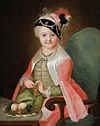 |
8 December 1699 – 17 November 1757 |
Archduchess of Austria, she married Augustus III, who was King of Poland and Elector of Saxony. |
| Leopold Joseph |
29 October 1700 – 4 August 1701 |
Archduke of Austria, he died when he was a baby. | |
| Maria Amalia Holy Roman Empress |
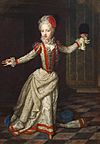 |
22 October 1701 – 11 December 1756 |
Archduchess of Austria, she married Charles VII, Holy Roman Emperor. |
Images for kids
See also
 In Spanish: José I de Habsburgo para niños
In Spanish: José I de Habsburgo para niños


